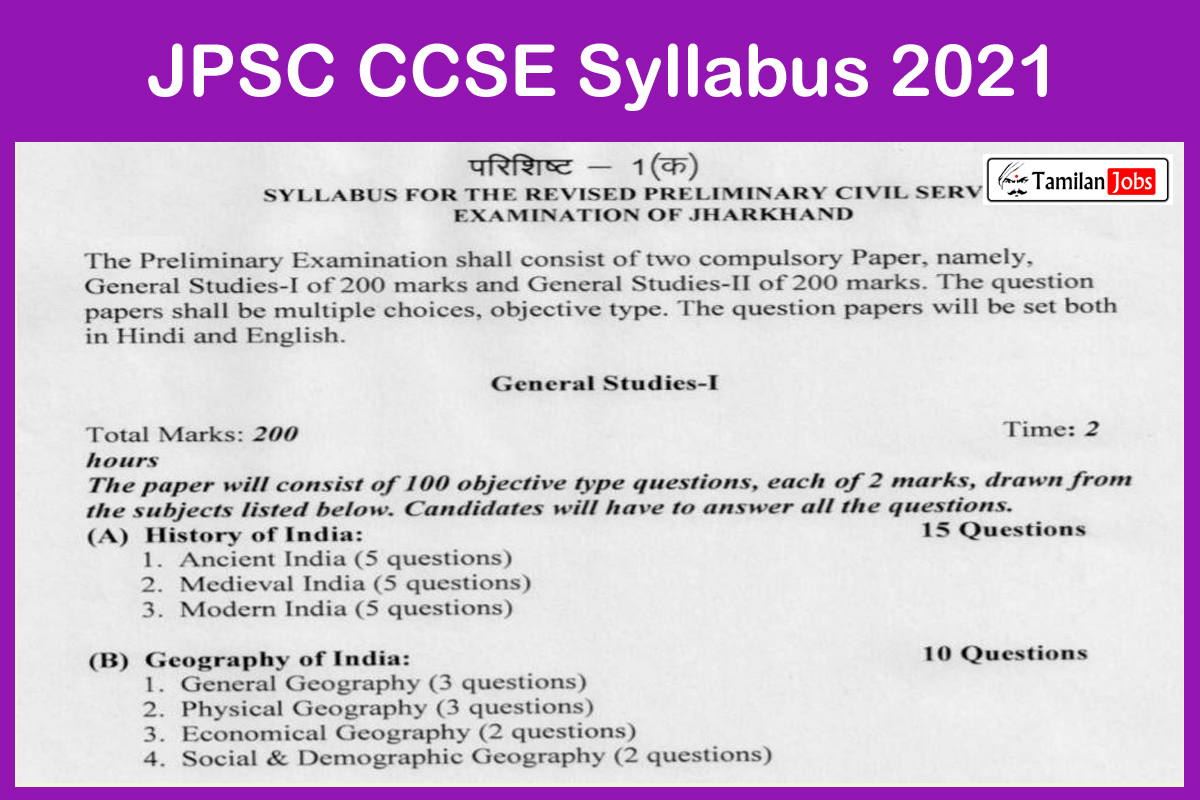JPSC CCSE Syllabus 2021 PDF Download Now @ www.jpsc.gov.in: The officials of Jharkhand Public Service Commission has released the syllabus and exam pattern for Civil Service Examination. many applicants have applied for this exam and don’t know how to prepare for this exam. All those applied candidates, read this complete article. We have provided the JPSC CCSE Syllabus 2021 and Exam pattern on this page. So, All the applicants kindly go through the Syllabus, Exam Pattern which was described here.
JPSC CCSE Syllabus 2021 – Details

| Download JPSC Civil Service Exam Syllabus & Exam Pattern 2021 Details | |
| Organization | Jharkhand Public Service Commission (JPSC) |
| Exam Name | Combined Civil Services Exam 2021 (CCSE 2021) |
| Category | Syllabus |
| Exam Date | 19.09.2021 in two shifts from 10:00 AM to 12:00 Noon and from 2:00 PM to 4:00 PM |
| Status | Released |
| Job Location | Jharkhand |
| Official website | www.jpsc.gov.in |
JPSC Civil Service Exam Pattern 2021
Prelims
| Paper | Subject | Duration | Marks |
| Paper-1 | General Studies -I | 2 Hours | 200 |
| Paper-2 | General Studies -II | 2 Hours | 200 |
Mains
| Paper | Subject | Duration | Marks |
| Paper I | General Hindi & General English | 3 hours | 150 |
| Paper-II | Language and Literature | 3 hours | 150 |
| Paper III | Social Sciences | 3 hours | 200 |
| Paper IV | Indian Constitution & Polity | 3 hours | 200 |
| Paper V | Indian Economy | 3 hours | 200 |
| Paper VI | General Sciences | 3 hours | 200 |
JPSC CCSE Syllabus 2021
Prelims
| Subject | Syllabus |
| General Studies Paper-I | History of India
· Ancient India · Medieval India · Modern India Geography of India · General Geography · Physical Geography Economical Geography · Social & Demographic Geography Indian Polity and Governance · Constitution of India · Public Administration and Good Governance · Decentralization: Panchayats & Municipalities · Economic and Sustainable Development · Basic features of Indian Economy Sustainable Development and Economic issues · Economic Reforms and Globalization Science and Technology · General science · Agriculture & Technology Development · Information & Communication Technology · Questions specific to Jharkhand · General Awareness · History · Society · Culture · Heritage Current Affairs (National & International) Miscellaneous · Human Rights · Environmental protection, Biodiversity & Climate change · Urbanization · Sports · Disaster Management · Poverty and unemployment · Awards · United Nations and other International Agencies |
| General Studies Paper-II | · History of Jharkhand
· Governance of Munda · Nagvanshi · Padaha Panchayat · Majhi Pargana · Munda Manki · Dhoklo Soho · Jaatiya Panchayat · Jharkhand Movement · Tribal of Jharkhand · Freedom Fighters of Jharkhand · Nobles of Jharkhand · Jharkhand Movement and Formation of the State · Specialty of Jharkhand · Social status of Jharkhand · Cultural status of Jharkhand · Political situation of Jharkhand ·Economic condition of Jharkhand · Religious characteristics and identity of Jharkhand · Culture of Jharkhand · folk literature · Traditional art and folk dance · Folk music and instruments · Places of interest – Natural, archaeological, historical, religious, and modern sites · Tribal-Caste-Species and Characteristics · Jharkhand Literature and Litterateur · Premier Educational Institutes of Jharkhand · Sports of Jharkhand · Land laws of Jharkhand · Chotanagpur Tenancy Act (C.N.T.) · Santhal Pargana Tenancy Act (S.P.T.) · Other state bills act · History of Economic Development in Jharkhand after 1947 and Geography of Jharkhand · Industrial Policy, Displacement, and Rehabilitation Policy and other policies of Jharkhand · Name and location of major industry and industrial development in Jharkhand · Major schemes and sub-plans of Jharkhand · Forest Management and Wildlife Conservation of Jharkhand · Facts related to environment of Jharkhand state, environmental change happening and its Mitigation & Adaptation and related topics · Disaster Management in Jharkhand · Miscellaneous facts and current affairs related to Jharkhand |
Mains
| Subject | Syllabus |
| Paper I: General Hindi and General English |
|
| Paper-II: Language and Literature | Candidates have to choose from one of the following languages and literature:
Check out the detailed syllabus for all the languages on the official JPSC website. |
| Paper III: Social Sciences, History and Geography | History: Ancient period
Medieval Period:
Modern Period:
History of Jharkhand:
Geography: Physical Geography (General Principles)
Physical and Human Geography of India:
Natural Resources of India: Development and Utilization
Geography of Jharkhand and utilization of its resources.
|
| Paper IV: Indian Constitution, Polity, Public Administration and Good governance |
|
| Paper V: Indian Economy, Globalization, and Sustainable development |
|
| Paper VI: General Sciences, Environment & Technology Development | Physical Science:
|
JPSC Civil Service Exam Syllabus 2021 – Click Here ![]()

